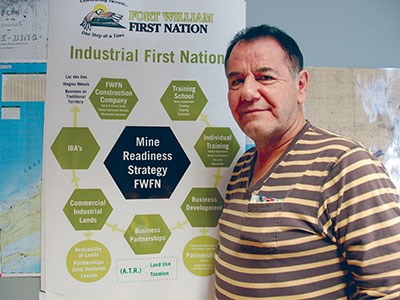Wally Bannon isn't one to let opportunity slip away.
Fort William First Nation's economic development officer knows having a skilled workforce is key for Aboriginal people to maximize the benefits from resource development.
“From my background (as a business adviser) with the Nishnawbe Aski Nation, I’ve been through the Musselwhite and Victor mine developments, and I've seen all the opportunities missed by the First Nations because they were not prepared.”
To that end, the reserve across the Kam River from Thunder Bay has become a construction training ground.
The band developed an aggregate pit and crushing operation run by its own members with equipment acquired with its own money. Trainees are steadily rebuilding the community's network of roads.
The settlement of a 160-year-old land claim with Canada and Ontario in 2011 delivered $154 million in compensation and placed the community of 930 in a unique position to invest in new employment opportunities.
“Now we have some equity and operating dollars that we can put towards starting to build that capacity to take us to that next level,” said Bannon.
A private contractor, Sean Main, was hired to train its members to operate bulldozers, crushers and graders.
“He was able to train people with no skills, little education, and a lot of them were carrying baggage from drug, alcohol and family problems.”
Bannon said they now have a reliable workforce of 29 that could work for any contractor in Thunder Bay.
In its first year of operation, Bannon said they've stockpiled enough aggregate to possibly sell it to the City of Thunder Bay, the Ministry of Transportation, mining companies or contractors.
Fort William stands to benefit from the legal requirement for industry and government to consult with First Nations on resource extraction projects.
The band's traditional lands run east to Lake Nipigon, north to the James Bay Treaty 9 area, and south to include Isle Royale in Michigan.
“A lot of agreements will come down the pipe, be it in mining or energy, and because of the duty to consult and accommodate, many business opportunities will spawn out of these,” said Bannon.
Fort William and Thunder Bay are teaming up in its promotional efforts to become a regional mining supply hub.
With the near-term potential for 10 new mines in the northwest and the Ring of Fire, Bannon believes Fort William can become an Aboriginal training and business cluster to supply labour and service for the developments to come.
One of the band's cornerstone projects is a $1.5-million training school, scheduled to open next spring. An industrial building is being refurbished near the former Abitibi Mission Mill to house classrooms, simulators and various pieces of heavy equipment.
Next up is the creation of a construction company which Bannon hopes can eventually create Aboriginal instructors to teach skills to others.
“My vision for the $800-million road from the Ring of Fire to Nakina is that we partner with the five First Nations to show them how to build it. We're all in this together and the best way to do this is to teach as many as possible to take advantage of these opportunities.”
Last March, the community staged a mining conference themed on youth, women in mining and Aboriginal training. The event spurred discussion with mining companies looking to recruit as they edge closer to project construction.
The reserve also has an extensive industrial land package of 1,600 acres that's ripe for brownfield and industrial park development.
The land, which once belonged to the First Nation, was expropriated by CN Rail in the early 1900s. Fort William regained title in 1999 and with it came already established companies like Coastal Steel Construction, Sterling Pulp Chemicals, McAsphalt Industries and other businesses.
A promotional campaign is in the works for next year to market the lands. One possibility that's been discussed is whether Fort William First Nation could host a hydrometallurgical plant.
Both Cliffs Natural Resources and Noront Resources have reviewed these lands as potential mineral processing sites.




